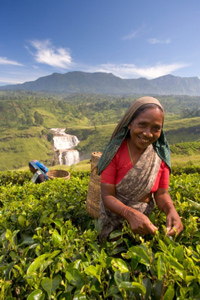Tea Profile: Ceylon
Ceylon, or the Island Nation of Sri Lanka as it is known today, owes its prominence in the world of tea in large part to the efforts of Sir Thomas Lipton. In the closing years of the Nineteenth Century, Lipton was bringing to England twenty thousand chests of the stuff, from both his own estates (he owned several) and other Ceylon gardens. He not only introduced Ceylon to England, but made famous the marketing term of "Orange Pekoe." Here is where it gets interesting: Orange Pekoe is a grading mark for a particular leaf size. The thing to remember is that Lipton's teas did not include whole tealeaves. A great marketer, he combined the term Orange Pekoe (even though his teas were broken leaves of lesser cost) and used the Ceylon characteristic of brightness, to sell his products as "brisk." The teabags we know today are not Orange Pekoe, rather they are what the industry terms "dust" from tealeaf leftovers.

Now back to the respectable Ceylon teas: Sri Lanka is the third largest producer of teas in the world. It is also the largest exporter of black teas. Over half a million of its acres grow mostly black teas. And Ceylon is the youngest of the tea-growing counties. In fact, until 1896 Ceylon was known for coffee production. That year, a disease destroyed the coffee plantations and tea was introduced as a replacement.
The differences between Ceylon teas are more subtle than those of say Darjeeling or Assam. Teas are classified according to elevation (the higher the better): Low-grown (up to two thousand feet), Mid-grown (two to four thousand feet) and High-grown (above four thousand). We have to admit, there are some wonderful silver-tip teas that are Low-grown, but the tea from muggy low country tends to be quick-growing, lush and typically course. Ceylon's reputation for quality rests on the laurels of the mountainside High-grown teas from the regions of Dimbula, Uva and Nuwara Eliya (pronounced nu-rel-iya). These have a mild, brisk flavor and a lively, pleasant aroma.
Sri Lanka is a tropical island. Therefore its teas are produced year round in the Mid and Low-grown regions. But the quality of High-grown Ceylon varies with the weather. If rain is in excess, the tea grows in abundance, but looses its distinctiveness. Therefore the best Ceylon teas are those that come from the High-grown estates in the dry months preceding the monsoons. These are not as plentiful, but much richer in quality.
Ceylon teas are, in general, well-twisted, wiry, long leaves that are very easily identified by sight. The broken grades might not appeal to the connoisseur pallet, but they are extremely popular as blending teas, adding flavor, color and brightness to almost any mix. You might want to keep an eye out for the better gardens, such Kenilworth, Pettiagalla, and New Vithanakande, as many are now marketed by name.

